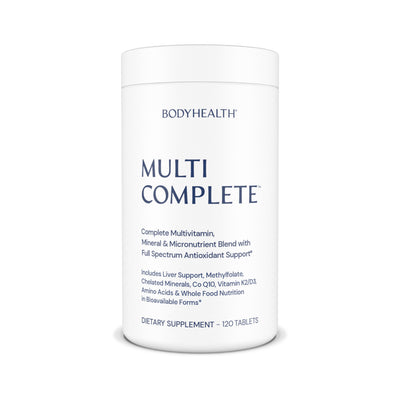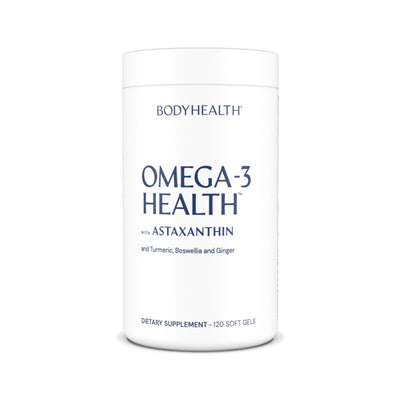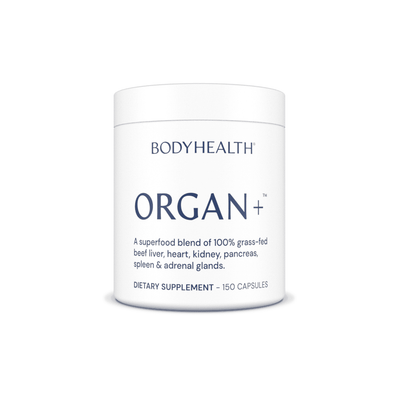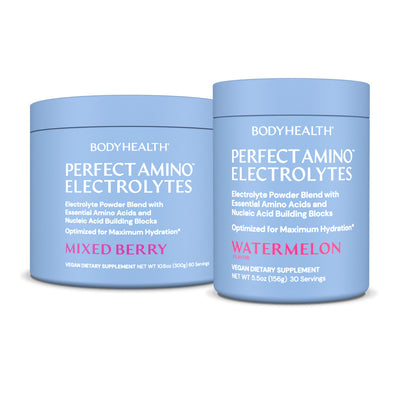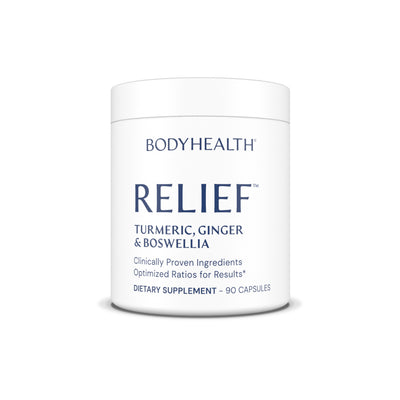Thyroid, Estrogen & Progesterone: Speeding Fat Loss & Lean Muscle Creation
March 31, 2024 10 min read

We’re entering Week Three of the Lean Body/Lean Bulk Challenge!
If we are doing the Lean Body program, we should be slimming down and added muscle should be toning and shaping our body.
If we’re doing the Lean Bulk portion, we should also be reducing body fat while increasing overall lean muscle.
But this is largely due to our hormonal balance improving, allowing our body to utilize the nutrients we’re consuming for what we want and not for what we don’t want.
We’ve already covered how high Cortisol hinders fat loss and slows muscle growth. As well as how Growth Hormone, Testosterone and IGF help to speed fat loss and muscle growth.
But there is another aspect to this balancing act: Estrogen, Progesterone and Thyroid.
These hormones exist in both women and men, and are each necessary in proper amounts.
But when they go out of balance, they can create a vicious spiral that raises cortisol and cravings for junk food, lowers growth hormone, testosterone and IGF, and make gains much harder all around.
This is a longer article, but one of the most important. It hasn’t been cut up into individual articles only because each part needs to be examined with each other part.
And
So let’s take a look at what’s happening here.
WHAT IS ESTROGEN DOMINANCE
In both women and men, estrogen exists and is necessary.
But when estrogen levels rise too high, it can unbalance other hormones and start a downward spiral that can be hard to get out of.
This causes excess body fat to be created, which can be hard to remove, and lowers key muscle-building hormones as well — testosterone and growth hormone.
And it lowers thyroid, which regulates our metabolism.
Our metabolism has to do with how much or how fast energy sources such as fat and sugar are used as fuel for our body vs being stored as body fat, and how much energy we have.
Excess estrogen also lowers levels of progesterone in women and men, which is a calming, fat-burning, testosterone-building hormone.
All of this leads to excess body fat that is harder to get rid of, decreased muscle mass, something called Gynecomastia, an enlargement of breast tissue in men and boys, worsened mood, higher stress levels, slower recoveries, and lower energy.
So let’s see what’s actually happening here, what causes this, and what we can do to reverse it.
First we’ll cover what each hormone is, then we’ll get into how this all works.
ESTROGEN, PROGESTERONE, TESTOSTERONE & THYROID
Estrogen is a category of three different hormones which promote the development and maintenance of female characteristics in the body — in women and men.
Estrogens help develop and maintain the reproductive system, contribute to cognitive health, bone health (lack of this is partially behind osteoporosis in women), a properly functioning cardiovascular system, and assist with many other essential bodily processes.
Estrogens also promote fat storage, and raise levels of insulin and cortisol, a hormone which breaks muscle down and prevents muscle building when high.
Progesterone is a hormone released by the ovaries which plays important roles in the menstrual cycle and in maintaining the early stages of pregnancy.
It’s also a precursor to testosterone, and also needed by men as well as women. Without it, testosterone couldn’t be produced, something necessary for muscle building.
And it promotes fat loss, calms us, and lowers insulin and cortisol levels.
Progesterone is the main hormone that keeps estrogen levels in balance.
Testosterone, like growth hormone, is a large factor in both muscle bulk and strength, as well as fat-burning.
It helps regulate sex drive, bone mass, fat distribution (where fat exists on the body), body composition, and the production of red blood cells and sperm.
As it’s the “male” hormone, we see much higher numbers in men than in women, though women still need this just as men still need estrogen, the “female” hormone.
Testosterone is also what gives that “chiseled” look. While estrogen creates curves, testosterone promotes more defined edges.
Thyroid is a hormone that regulates your metabolism: all the processes in the body that deal with the production and use of energy.
It works to increase energy production in each cell and the rate at which energy is used by the body. (And that energy is carbs and stored fat, something we want to be used).
It also makes other hormones and helps to regulate other hormones.
WHAT HAPPENS WHEN ESTROGEN LEVELS RISE TOO HIGH
Each of the above hormones are necessary for a properly functioning body, in both women and men.
But when levels of any of these rise too high, or drop too low, we have trouble.
And this makes muscle building and fat loss very difficult.
There is not one exact series of dominoes that fall when estrogen levels rise too high, but instead, a number of interlocking reactions take place, each of which further fuel estrogen increases in a gradual, worsening spiral.
But while estrogen is the pain point, progesterone, in men and women, is the key.
When progesterone levels rise, estrogen levels lower, and vice versa.
Each is necessary — but must be in balance with one another.
In women, progesterone is necessary for the reproductive process. And it’s a calming hormone. As it’s produced largely through the ovaries in women, on a monthly basis, this hormone lowers, and estrogen rises.
This can lead to worsened mood, cramps, and up to 5 pounds of water retention and bloating.
But when estrogen levels stay high for too long, our mood can stay lower and bloating doesn’t go away.
In men and women, progesterone is also a precursor to testosterone, a mood enhancing, muscle-building, fat-burning hormone. Meaning, our bodies use progesterone to make testosterone, and when progesterone levels are low, less testosterone is made.
Estrogen also works with the hormones insulin and cortisol, two fat building hormones. As insulin and cortisol rise, so does estrogen, and high estrogen keeps insulin and cortisol levels high.
And this is one key way we lose progesterone.
When estrogen raises, the command to raise cortisol is given. And this cortisol is made from progesterone.
So our bodies take a fat-burning hormone and make a fat-building hormone out of it.
This cortisol also operates on a sort of see-saw with testosterone. When testosterone raises, cortisol lowers, and when cortisol raises, testosterone lowers.
How does this happen?
High sugar levels.
Yes, you knew I’d say that. But it’s true.
Sugar raises insulin levels. A lot of sugar raises insulin levels high.
This triggers raised cortisol levels, which is created through the break down and re-synthesis of progesterone into cortisol.
Lowered progesterone leads to lowered testosterone and raised estrogen.
Estrogen leads to building more body fat and increased cravings for more… sugar.
And the cycle starts again.
If this is a constant cycle, estrogen levels can rise quite high.
This leads to levels of body fat we can’t get rid of no matter what. On men, it leads to something called Gynecomastia, an enlargement of breast tissue in men and boys, which can be quite hard to reverse even after we’ve lost the excess body fat.
But it goes further.
AROMATASE & MAKING NEW ESTROGEN FROM TESTOSTERONE
Beyond increasing body fat, estrogen actually gets stored in the fat cells.
But, these fat cells also trigger more fat storage because… they synthesize estrogen from other hormones, like testosterone.
They actually convert these hormones into estrogen.
So estrogen levels go up, which pushes fat storage up. And as fat storage goes up, estrogen levels go up.
This is because of something called aromatase, an enzyme produced by our fat cells.
As far as chemical profiles go, testosterone and estrogen are nearly identical.
So they can easily be interchanged within the body, converting testosterone into estrogen or estrogen into testosterone.
(We actually see this happening as men and women get older. In women, testosterone levels increase, and in men, estrogen levels increase. But that’s another topic.)
Now, aromatase, is an enzyme produced by fat cells. And it takes testosterone and converts it into estrogen.
So we have estrogen building body fat, the body fat releases aromatase which converts testosterone into estrogen, which further raises body fat levels, on and on.
This is why, the more body fat we carry, the less testosterone we have. Because the more body fat we have, the more aromatase we produce, which converts testosterone into estrogen
Also, at the same time that insulin raises estrogen levels, excess estrogen causes an organ called the pancreas to over-produce… insulin. So you get even more fat storage… which then synthesizes more estrogen.
Do you see the trouble here?
And it really is caused by all of this extra sugar in our diets today.
But it also causes trouble with our thyroid.
HIGH ESTROGEN EQUALS LOW THYROID
Your thyroid hormones control your metabolism, your ability to burn sugar and fat, and make energy.
Now, thyroid is made from Iodine and the amino acid Tyrosine.
When our levels of amino acids are low, or our levels of iodine are low, we get low levels of thyroid.
To increase thyroid production, first raise your amino acid levels and make sure iodine is in your diet.
But estrogen also plays a part in this, by either stopping your body from being able to use the thyroid it does have, or removing the thyroid hormone all together.
Here’s how:
First, excess estrogen blocks the receptor sites on cells that thyroid uses to communicate with them. So, even if you have proper levels of thyroid, this makes it harder for the cells to see it and for thyroid to tell the cells to burn energy (sugar, fat) for use.
But excess estrogen also causes the liver to produce high levels of something called thyroid binding globulin. This decreases the amount of thyroid available to be used by literally gobbling up the thyroid hormone in the blood stream.
This low level of thyroid can result in fatigue, brain fog, hair loss, low libido, and weight gain.
But, because we now have less thyroid… we get even more estrogen.
This is because excess estrogen must be broken down by the liver. But the liver needs thyroid to do this and so the less thyroid we have, the less estrogen is broken down and it further builds up in the body.
So… more estrogen equals less progesterone, thyroid, and testosterone… and more insulin, body fat, and cortisol… which equals less progesterone, testosterone, and thyroid… which equals more estrogen, which equals, which equals, which equals…
You get the point. It’s a vicious circle.
This is Estrogen Dominance.
Now enter progesterone.
HOW PROGESTERONE BALANCES EVERYTHING
Progesterone balances estrogen. It lowers blood sugar levels, lowers insulin production, and lowers cortisol levels.
And, while high levels of estrogen can cause so much excess insulin to be produced that insulin resistance can result… progesterone does the opposite, making the cells more insulin sensitive, so they require less insulin.
Also, while estrogen lowers thyroid, progesterone raises it. This is because progesterone lowers that thyroid binding globulin that estrogen makes, which gobbles up thyroid.
So we get more thyroid and increased fat burning for energy.
This progesterone is also now not being converted to cortisol, so our stress levels lower, and testosterone can be produced.
While high levels of estrogen can make one depressed and anxious more often, cause trouble sleeping, and increase inflammation in the body… progesterone is calming, lowers inflammation, and helps one sleep better.
Now, I know that was long, but I wanted you to see how each hormone really affects the other.
So what do we do about this?
IMPROVING ESTROGEN, PROGESTERONE & THYROID BALANCE
First: Protein.
This is key. Our bodies need proper levels of protein to produce the hormones in the first place.
The amino acids in proteins are key to building progesterone, testosterone, and thyroid.
And they also lower cravings for the sugar that causes this trouble in the first place.
Cutting out sugars is next. At least the processed sugars and breads.
These don’t help us.
We also have magnesium and fiber being very important.
Fiber helps remove excess estrogen and stabilizes blood sugar levels.
Then magnesium. Magnesium is very calming, helping to lower cortisol levels before sleep, and most people are deficient in it as it’s actually processed out of a majority of our foods these days.
Vitamin B6 also helps reduce estrogen levels in the blood.
And, as thyroid is made from tyrosine, an amino acid, and iodine, then as long as we’re getting our iodine and PerfectAmino in, our body is more able to produce thyroid, helping all of this.
Dong the above along with the other aspects of the Lean Body/Lean Bulk Protocol goes a long way toward balancing these and other hormones in our body.
In fact, it is designed specifically to do that.
So keep going, we're only two weeks in, and let's see just how far we can get.
If you have any questions or need anything, make sure to message us in the Group. And make sure to share your progress there and see others' progress.
And if you’re just seeing this and want to know more about building a Lean Body or Leaning Bulking, you can find out more here.
Index To The Lean Body/Lean Bulk Guide:
Introductory Articles:
Getting Started:
- The Lean Body/Lean Bulk Guide & 30-Day Challenge
- Hormones: The Third Dimension of Calorie Cutting
- The Lean Body/Lean Bulk Diet
Supplements & Macros By Goal:
- Supplements & Macros For Lean Body
- Supplements & Macros For Beginner To Moderate Lean Bulking
- Supplements & Macros For Advanced Lean Bulking
Workout Regimens & Exercise Videos:
- Beginner to Moderate Level Workout Regimen
- Advanced Workout Regimen
- Lean Body/Lean Bulk Exercise Videos
Week One:
- Metrics & Key Data For Week One
- How BCAAs Build Body Fat & Lower Health Over Time
- The Importance Of Complete Protein Digestion
Week Two:
- Dialing In Our Macros For Lean Muscle: Hormones & Cravings
- How Cortisol Breaks Down Muscle & Prevents Protein Synthesis
- How To Improve Growth Hormone, Testosterone & Protein Synthesis
Week Three:
- Thyroid, Estrogen & Progesterone: Speeding Fat Loss & Lean Muscle Creation
- Improving Sleep: Muscle Building, Fat Loss, Mood & Aging
- Maximizing Cellular Function For Endurance & Recovery
Week Four:
- Raising VO2 Max: Endurance, Performance & Recovery
- How Toxins Affect Our Hormones: Building Muscle & Fat Loss
- Blood Flow For Muscle, Fat Loss & Overall Health
Final Week:
Articles by Health Topic
Your Path To Better Health Starts Here!
From in-depth articles on nutritional benefits to updates on new product launches, stay informed and inspired on your journey to optimal health.
*These statements have not been evaluated by the Food and Drug Administration. These products are not intended to diagnose, treat, cure, or prevent any disease.

